The Intel Core i9-9990XE Review: All 14 Cores at 5.0 GHz
by Dr. Ian Cutress on October 28, 2019 10:00 AM ESTCPU Performance: System Tests
Our System Test section focuses significantly on real-world testing, user experience, with a slight nod to throughput. In this section we cover application loading time, image processing, simple scientific physics, emulation, neural simulation, optimized compute, and 3D model development, with a combination of readily available and custom software. For some of these tests, the bigger suites such as PCMark do cover them (we publish those values in our office section), although multiple perspectives is always beneficial. In all our tests we will explain in-depth what is being tested, and how we are testing.
All of our benchmark results can also be found in our benchmark engine, Bench.
Application Load: GIMP 2.10.4
One of the most important aspects about user experience and workflow is how fast does a system respond. A good test of this is to see how long it takes for an application to load. Most applications these days, when on an SSD, load fairly instantly, however some office tools require asset pre-loading before being available. Most operating systems employ caching as well, so when certain software is loaded repeatedly (web browser, office tools), then can be initialized much quicker.
In our last suite, we tested how long it took to load a large PDF in Adobe Acrobat. Unfortunately this test was a nightmare to program for, and didn’t transfer over to Win10 RS3 easily. In the meantime we discovered an application that can automate this test, and we put it up against GIMP, a popular free open-source online photo editing tool, and the major alternative to Adobe Photoshop. We set it to load a large 50MB design template, and perform the load 10 times with 10 seconds in-between each. Due to caching, the first 3-5 results are often slower than the rest, and time to cache can be inconsistent, we take the average of the last five results to show CPU processing on cached loading.
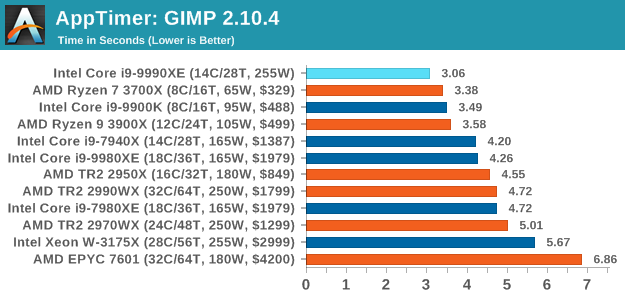
Application loading is a walk in the park for the Core i9-9990XE.
FCAT: Image Processing
The FCAT software was developed to help detect microstuttering, dropped frames, and run frames in graphics benchmarks when two accelerators were paired together to render a scene. Due to game engines and graphics drivers, not all GPU combinations performed ideally, which led to this software fixing colors to each rendered frame and dynamic raw recording of the data using a video capture device.
The FCAT software takes that recorded video, which in our case is 90 seconds of a 1440p run of Rise of the Tomb Raider, and processes that color data into frame time data so the system can plot an ‘observed’ frame rate, and correlate that to the power consumption of the accelerators. This test, by virtue of how quickly it was put together, is single threaded. We run the process and report the time to completion.

FCAT is getting fairly unified across all the processors, with only a few percent separating all the Intel parts.
3D Particle Movement v2.1: Brownian Motion
Our 3DPM test is a custom built benchmark designed to simulate six different particle movement algorithms of points in a 3D space. The algorithms were developed as part of my PhD., and while ultimately perform best on a GPU, provide a good idea on how instruction streams are interpreted by different microarchitectures.
A key part of the algorithms is the random number generation – we use relatively fast generation which ends up implementing dependency chains in the code. The upgrade over the naïve first version of this code solved for false sharing in the caches, a major bottleneck. We are also looking at AVX2 and AVX512 versions of this benchmark for future reviews.
For this test, we run a stock particle set over the six algorithms for 20 seconds apiece, with 10 second pauses, and report the total rate of particle movement, in millions of operations (movements) per second. We have a non-AVX version and an AVX version, with the latter implementing AVX512 and AVX2 where possible.
3DPM v2.1 can be downloaded from our server: 3DPMv2.1.rar (13.0 MB)
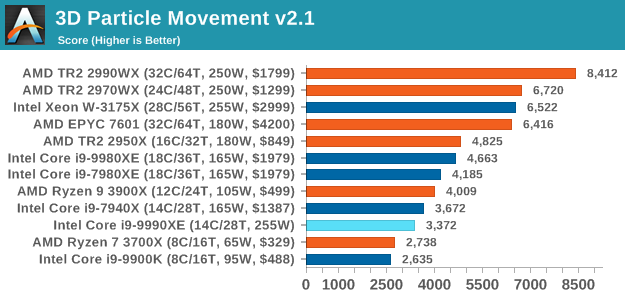
When we run our 3DPM test in a standard mode, the 9990XE again sees a slight regression compared to the 7940X, perhaps indicating that the mesh environment needs some extra MHz.
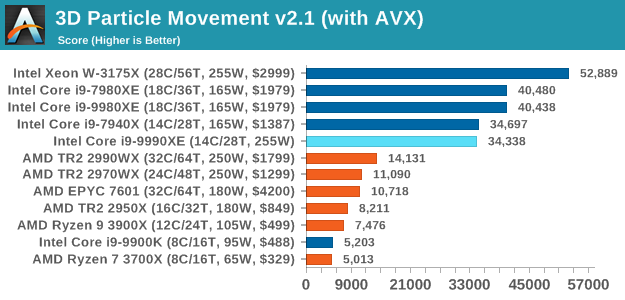
When adding AVX512 into the mix, the 9990XE rises up as with all the other Intel HEDT CPUs, but still can only match the slower 7940X despite having the same number of cores. At this point we're more core limited than frequency limited, indicating that there are some pipeline stalls in this test.
Dolphin 5.0: Console Emulation
One of the popular requested tests in our suite is to do with console emulation. Being able to pick up a game from an older system and run it as expected depends on the overhead of the emulator: it takes a significantly more powerful x86 system to be able to accurately emulate an older non-x86 console, especially if code for that console was made to abuse certain physical bugs in the hardware.
For our test, we use the popular Dolphin emulation software, and run a compute project through it to determine how close to a standard console system our processors can emulate. In this test, a Nintendo Wii would take around 1050 seconds.
The latest version of Dolphin can be downloaded from https://dolphin-emu.org/
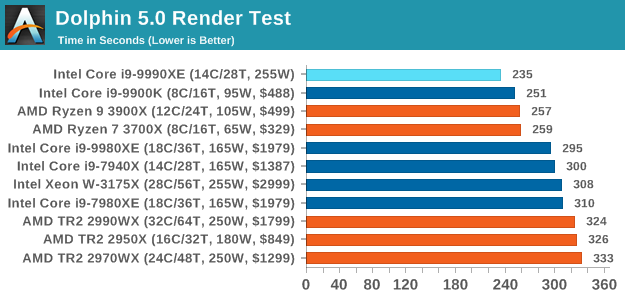
Dolphin is a heavily single threaded test, so we see the highest frequency from Intel and AMD at the top here.
DigiCortex 1.20: Sea Slug Brain Simulation
This benchmark was originally designed for simulation and visualization of neuron and synapse activity, as is commonly found in the brain. The software comes with a variety of benchmark modes, and we take the small benchmark which runs a 32k neuron / 1.8B synapse simulation, equivalent to a Sea Slug.

Example of a 2.1B neuron simulation
We report the results as the ability to simulate the data as a fraction of real-time, so anything above a ‘one’ is suitable for real-time work. Out of the two modes, a ‘non-firing’ mode which is DRAM heavy and a ‘firing’ mode which has CPU work, we choose the latter. Despite this, the benchmark is still affected by DRAM speed a fair amount.
DigiCortex can be downloaded from http://www.digicortex.net/
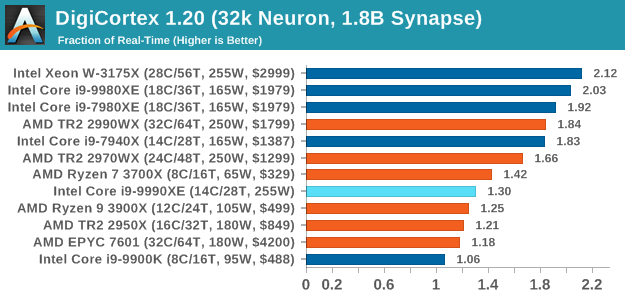
DigiCortex likes memory frequency and internal speeds more than raw core frequency, and again the 9990XE doesn't perform too well here.
y-Cruncher v0.7.6: Microarchitecture Optimized Compute
I’ve known about y-Cruncher for a while, as a tool to help compute various mathematical constants, but it wasn’t until I began talking with its developer, Alex Yee, a researcher from NWU and now software optimization developer, that I realized that he has optimized the software like crazy to get the best performance. Naturally, any simulation that can take 20+ days can benefit from a 1% performance increase! Alex started y-cruncher as a high-school project, but it is now at a state where Alex is keeping it up to date to take advantage of the latest instruction sets before they are even made available in hardware.
For our test we run y-cruncher v0.7.6 through all the different optimized variants of the binary, single threaded and multi-threaded, including the AVX-512 optimized binaries. The test is to calculate 250m digits of Pi, and we use the single threaded and multi-threaded versions of this test.
Users can download y-cruncher from Alex’s website: http://www.numberworld.org/y-cruncher/
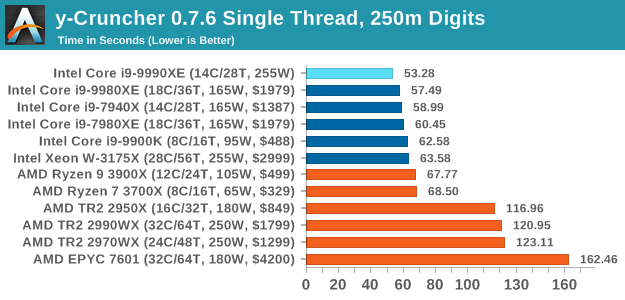
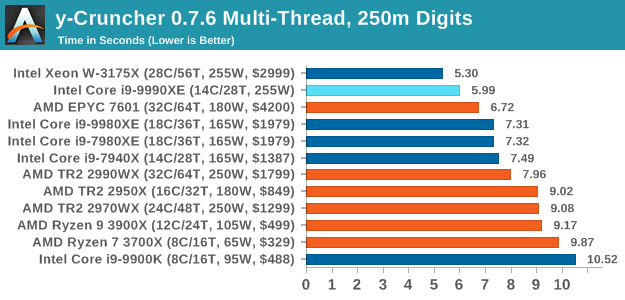
y-Cruncher is an AVX-512 accelerated test, and with the high frequency it gets the top score in our ST test.
Agisoft Photoscan 1.3.3: 2D Image to 3D Model Conversion
One of the ISVs that we have worked with for a number of years is Agisoft, who develop software called PhotoScan that transforms a number of 2D images into a 3D model. This is an important tool in model development and archiving, and relies on a number of single threaded and multi-threaded algorithms to go from one side of the computation to the other.
In our test, we take v1.3.3 of the software with a good sized data set of 84 x 18 megapixel photos and push it through a reasonably fast variant of the algorithms, but is still more stringent than our 2017 test. We report the total time to complete the process.
Agisoft’s Photoscan website can be found here: http://www.agisoft.com/
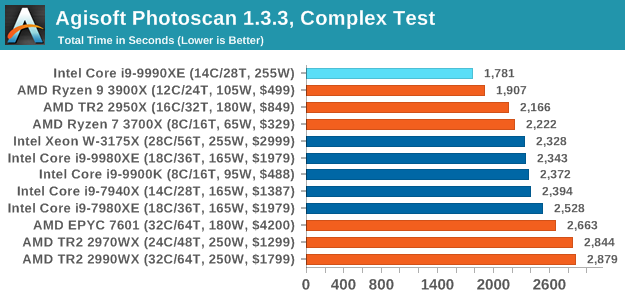
Agisoft is a variable threaded workload, and it seems the Core i9-9990XE has the best combination of cores and threads.












145 Comments
View All Comments
xrror - Monday, October 28, 2019 - link
Hey Ian, please again thank ICC for letting you guys have a full run though with one of these systems.While yes, this will never be a practical option for the vast majority of people, it IS one VERY AWESOME datapoint(s) for benchmark purposes. No more hypothetical "but what if 5Ghz Skylake" no - you have actual numbers, it shows the scaling for Intel's current'ish gen out to the extreme end.
I hope you are able to run more on this box to fill out the numbers in Bench - (which you may have already, I haven't actually looked yet).
Again thanks to ICC and Anandtech for this.
MrAndroidRobot - Monday, October 28, 2019 - link
If like to see how the 3900X fairs in comparison given its 12C/24T and holds up well against current TR/HEDT CPUskrumme - Tuesday, October 29, 2019 - link
I cant really tell how this is different from my 8700k from a performance perspective.Looking at the article i think this is cheap marketing. Good move. But anyways it's crazy 14c cpu is now touted for their single thread performance. Seriously one have to wonder the meaning of all this. What am i doing here? Lol
TheJian - Tuesday, October 29, 2019 - link
Please test SLOWER/VERY SLOW not FAST/FASTER for encoding. I would not STORE anything ripped at FAST/FASTER...LOL. Who rips at this crap quality level? Besides, with 14c why wouldn't you want top quality (or fairly close)? It's not much more time and might yield completely different results. Never understood why people keep running tests that are NOT how we would USE the tested device/game etc. Test it like we USE it or quit wasting your (our?) time.Raise your hand if you're ripping your blurays with fast/faster settings...Nobody. You can rip with SLOWER faster than you can create the content on these chips today, so why ruin your vid? L4.1 HIGH, VERY SLOW. Done (and I do 2pass, control other settings too, but you get the point). Nobody is archiving anything with your settings right? Emulate the pirates (seriously, one NFO file can tell you a LOT about these settings) :) They would NUKE your rip. Mediainfo can tell you all the settings also if you don't know where to get an nfo file from the people who've been ripping since the net started...LOL. Just saying...It's like claiming 1440p is the new enthusiast resolution (Ryan did this in his 660ti article...ROFL - see the comment section where I destroyed that crap), which isn't even true TODAY...LOL. YEARS later. Wake me when 1440p hits 10%. Right now it takes 1440p+4k to hit ~6.5% total...ROFL. 1440p is STILL not even 5% yet (4.98...ROFL). 1080p however 65%! Hmm, where should we spend MOST of our time testing then? Ah, UNDER 1440p with 4k being a complete joke still at 1.6%.
https://store.steampowered.com/hwsurvey/Steam-Hard...
Wrong still for 7yrs Ryan Smith, AND counting. Is 10% even good enough to call it the new enthusiast resolution? Maybe Ryan will be right 2020. I digress...Don't even get me started on the complete BS that 4k testing is (1.6% of 130mil steam users say 4k is still dead). Apparently people don't like turning crap down (that devs meant for us to SEE) as much as Ryan etc think. :)
GreenReaper - Tuesday, October 29, 2019 - link
It's true that relatively few systems have a high-resolution screen. In fact I'd go further and say that for general usage of current systems, the combination of 4K+1440p is closer to 3% (with 1440p being ~2.5% of that). That's what I see on my media hosting website.However, enthusiasts *are* the 3%. Or at least a lot of it. Most people use all-in-ones, work laptops, or school netbooks. They may install Steam on them and game on them, because they have to - they probably didn't buy new hardware specifically to do so. Reviews are all about new hardware.
If they *did* want to buy a new piece of video hardware, they may want to know how it'd perform if also buying a 1440p monitor and plug it in, perhaps once prices come down a bit. Or even 4K!
It's also a better way to measure GPU power than running them in a CPU-limited zone (after all, your GPU may end be paired with a future CPU by the time you buy it). The higher-end cards that tend to be reviewed are also intended to potentially last multiple CPU cycles - in reality I suspect most buy something further down the scale and just use it with one CPU, but it's an option.
Your point is fairer with IGP, but that's what IGP level is for. Most serious gamers are not using IGP. And this review doesn't *have* any GPU tests, though, so your comment may be better saved for one that does; it came off as ranting a little too hard about Ryan. :-)
TheJian - Wednesday, November 6, 2019 - link
Of course reviews are about new hardware...But the point is about HOW you test them. Are you acting like I'll MAYBE, if the wind blows right, stars align, etc, in 5yrs, or are you testing for what we will do with it for the next few years NOW? You know, like what I actually BOUGHT it for, NOW. I'm an enthusiast (know pretty much only them, since only deal with IT people pretty much), and have nothing like what they are pushing (no 4k desire for anyone I know, most not on 1440p). It isn't because I can't afford 4k, just don't care (for many reasons currently, lacking gpus for one, you need TWO still). I can afford those two titans every month too, but what for? They'd fry me in my PC room after 30mins of gaming due to heat in my state. So I'm stuck waiting for a 7nm NV card that takes AMD's 7nm a step further in watts heat (or I'll just downclock their no doubt better 7nm version since they waited) so I can play my next monitor (hopefully xmas this year or next) at max details, and of course my current 1920x1200 will be maxed finally by it until I finally see a monitor I want (c'mon dell 30+ with gsync). I'll pay $1200, just make it!I see nothing wrong with "ranting" (not how I see it, but whatever) if you're still right and it is relevant to 95% of users who are STILL not using stuff like they seem to think we do (and you keep testing stuff WRONG over and over). The point is a pattern of reviewing products in ways we don't actually use them. If 95% of users were running 4k monitors, it would be just as stupid to test 720p all day in every review right? Unless you're trying to prove a specific point by doing said test, there is no reason to wash rinse and repeat this. Your review should cover your audience NOW, with a mention of the future maybe as an afterthought (like RTX on day one, hmm, hope they use it). RTX didn't fly off the shelves until more about the features came out. Most people don't care about the future of their tech, they are buying for today's perf or features they need.
No, The same people buy new titans yearly (Multiple Titans in many cases, 4 at a time, 2080ti's also) according to Jen Hsun himself. The bulk of top sales go to the same rich who can afford them yearly easily. Heck I can afford them too (easy with no Visa bills, no car (cash), no cell, no cabletv (just HSI), just don't care to act rich for not much more perf :)
More than 3% buy enthusiast cards. Heck 3% of sales is likely Titans alone, and that card alone is not what I call enthusiasts (Ryan thought it was 660ti back then, it was NOT the top card, probably correct too, but it wasn't built for 1440p he was pushing). Anything over $250, you're probably more than a casual gamer.
NO serious gamer is using igp...LOL. Do you know serious gamers who play 720p with details down? I don't say NEVER test 4k or 1440p, I say there is no need to spend 2/3 of each review of gpus on this crap (you can read many posts of mine in reviews like this). TEST more of what we PLAY at NOW, RIP at quality levels most would want to watch, etc. When the future comes, I'll be on other hardware (probably most enthusiasts huh?)...ROFL. Test a few games a year in a 4k review, no need to do it repeatedly as if it is used by more than a few %. People are FAR more interested in how it works NOW as I use it, than "futureproof" junk I may never use if nobody supports it ever. I'm not against testing a 4k game per review, but not a 4k test for every game in said review. Same for ripping, I humbly ask who watches this crap quality? Why are all the ripping tests in crap qual? They turn off stuff users specifically BUY NV cards for. You know, like acting CUDA wouldn't be used by a NV buyer if they had a choice. Nobody buys NV to do OpenCL...ROFLMAO. You buy for CUDA if you can for your app. I could go on, but you should get the point: TEST IT LIKE WE USE IT, no matter what you're testing today, tomorrow, etc.
My point is fair for ALL single gpu cards, as there isn't one yet that can do 4K on ALL games without turning tons of crap down on a per game basis. Pricing isn't bad, so this is clearly a big deal to people. No point in buying something new, only to degrade it's perf out of the box just to get enough fps to enjoy your game (not as the dev intended you to see it at this point either). But, then, I don't enjoy that game at this point. I need the details ON.
IF, if, but, maybe...blah...How about spending MOST of your time testing what we actually DO with whatever you are reviewing, instead of wasting time on what YOU WISH we used this stuff for. This is why Anandtech is my last resort these days and tomshardware even less used (same site really now).
mode_13h - Tuesday, October 29, 2019 - link
Isn't the myth of high-frequency traders using tuned CPUs a bit overblown? I'm not saying it doesn't happen, but would they really even go so far as to forego ECC memory?MrSpadge - Tuesday, October 29, 2019 - link
I guess you have to be fastest to earn serious money. And there's no "fast" ECC RAM in terms of desktop OC. If with ECC you can get a guaranteed answer too late, it's not going to matter. Better risk the seldom error without ECC - it's probably going to be fine...Bp_968 - Tuesday, October 29, 2019 - link
So I'm a true blood capitalist but I just don't see the utility or reason for existence for "high speed trading". They are making money on the difference between prices at the millisecond level. It offers nothing back to society and seems to exist only due to how stock and commodity trading works.Stocks should exist for public ownership of companies, to provide funding for those companies and hopefully for the stockholders to benefit from the growth and profit of said companies.
It shouldn't exsist as a glorified casino game, which is essentially what "high speed trading" is.
crotach - Tuesday, October 29, 2019 - link
So it's good at compiling stuff?